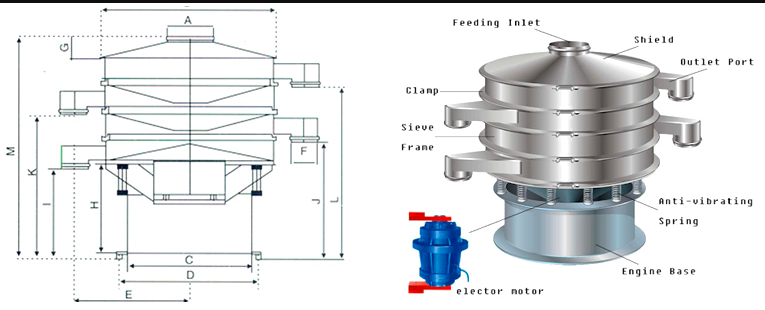Exploring Round Vibratory Sieve: Design, Advantages, and Applications

Introduction
Round Vibratory Sieve are pivotal in industrial processes that require the separation and classification of bulk materials. They use a circular vibrating motion to effectively screen materials through mesh screens, making them ideal for various applications in industries such as food processing, pharmaceuticals, and chemicals. This article provides an in-depth look at Round Vibratory Sieve, including their design features, benefits, and key applications.
1. What is a Round Vibratory Sieve?
A round vibratory sieve is a type of screening equipment that utilizes a circular motion to separate and classify materials based on particle size. Unlike linear vibratory sieves, which use a back-and-forth motion, Round Vibratory Sieve use a circular vibration to facilitate the movement of materials through a mesh screen. This design helps achieve uniform separation and efficient material flow.
2. Design Features of Round Vibratory Sieve
2.1 Construction Materials
Round Vibratory Sieve are typically made from high-quality materials such as stainless steel or carbon steel. Stainless steel is preferred for applications in food and pharmaceuticals due to its corrosion resistance, ease of cleaning, and durability.
2.2 Screening Surface
The screening surface of a round vibratory sieve consists of a mesh or perforated screen that can be customized to various mesh sizes. The mesh size determines the particle size that can pass through, and screens are often designed to be easily replaceable to accommodate different processing needs.
2.3 Vibratory Mechanism
The vibratory mechanism of a round vibratory sieve includes a set of vibrators or motors that generate a circular motion. This vibration helps in evenly distributing the material across the screen and promotes efficient separation. The frequency and amplitude of the vibrations can be adjusted to suit different materials and separation requirements.
2.4 Circular Design
The circular design of the sieve helps in achieving a uniform distribution of materials over the screening surface. This design minimizes the risk of material build-up and ensures that particles are effectively screened and classified.
Read also: Oil Free Air Compressor Working Principle PDF: Understanding the Technology
2.5 Sanitary Features
For industries with stringent hygiene requirements, Round Vibratory Sieve are equipped with sanitary features such as smooth surfaces, quick-release clamps, and removable covers. These features facilitate easy cleaning and maintenance, ensuring compliance with hygiene standards.
3. Benefits of Round Vibratory Sieve
3.1 Efficient Material Separation
The circular vibration of Round Vibratory Sieve ensures efficient and precise separation of materials based on particle size. The design helps in evenly distributing materials across the screen, promoting effective classification and removal of oversized or undersized particles.
3.2 Versatility
Round Vibratory Sieve are versatile and can handle a wide range of materials, including powders, granules, and liquids. They are suitable for various applications due to their ability to process different particle sizes and types.
3.3 Easy Maintenance
The design of Round Vibratory Sieve facilitates easy maintenance. Features such as removable screens, quick-release clamps, and smooth surfaces make cleaning and routine maintenance straightforward, reducing downtime and operational disruptions.
3.4 Durability
Constructed from durable materials like stainless steel, Round Vibratory Sieve are built to withstand the demands of industrial environments. Their robust design ensures long-term performance and reliability, even with continuous use.
4. Applications of Round Vibratory Sieve
4.1 Food Processing
In the food processing industry, Round Vibratory Sieve are used to screen and classify ingredients such as flour, sugar, spices, and grains. They help remove contaminants and ensure that food products meet safety and quality standards.
4.2 Pharmaceuticals
Pharmaceutical companies use Round Vibratory Sieve to separate and classify active pharmaceutical ingredients (APIs), powders, and granules. The precision and sanitary design of these sieves are critical for producing safe and effective medications.
4.3 Chemicals
In the chemical industry, Round Vibratory Sieve are employed to filter and classify chemical powders and granules. They ensure that chemical products meet required specifications and help prevent contamination.
4.4 Plastics and Polymers
Round Vibratory Sieve are used in the plastics and polymers industry to remove contaminants from raw materials and ensure the quality of finished products. Their ability to handle various particle sizes and types makes them versatile for different applications.
5. Factors to Consider When Choosing a Round Vibratory Sieve
5.1 Material Characteristics
Consider the properties of the material to be processed, such as particle size, flowability, and abrasiveness. Choose a round vibratory sieve with the appropriate mesh size and construction materials to match these characteristics.
5.2 Size and Capacity
Determine the required size and capacity of the sieve based on the volume of material to be processed and the available space in your facility. Proper sizing ensures that the sieve can handle the required throughput efficiently.
5.3 Regulatory Compliance
Ensure that the round vibratory sieve complies with relevant industry regulations and standards for hygiene, safety, and performance. Verification of compliance is essential for industries subject to strict regulatory requirements.
5.4 Maintenance and Support
Select a sieve from a reputable manufacturer that offers comprehensive support and maintenance services. Regular maintenance and prompt support are crucial for ensuring the continued efficiency and longevity of the equipment.
6. Maintenance and Troubleshooting
6.1 Regular Inspections
Conduct regular inspections to check for signs of wear, damage, or material build-up. Inspect the vibratory mechanism, screen, and other components to ensure that the sieve is functioning correctly.
6.2 Cleaning Procedures
Follow recommended cleaning procedures to maintain hygiene and prevent contamination. Use appropriate cleaning agents and methods to ensure that the sieve is thoroughly cleaned and sanitized.
6.3 Troubleshooting Common Issues
Address common issues such as uneven separation, vibration problems, or screen damage promptly. Identifying and resolving these issues quickly helps maintain optimal performance and prevents operational disruptions.
Conclusion
Round Vibratory Sieve play a crucial role in material handling systems by providing efficient and precise separation of bulk materials. Their design, versatility, and ease of maintenance make them valuable assets in various industries. By understanding their features and applications, businesses can select the right round vibratory sieve to meet their specific needs, ensuring high-quality outcomes and compliance with regulatory standards.




